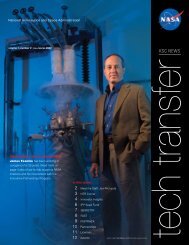2006-2007 - Kennedy Space Center Technology Transfer Office
2006-2007 - Kennedy Space Center Technology Transfer Office
2006-2007 - Kennedy Space Center Technology Transfer Office
- No tags were found...
Create successful ePaper yourself
Turn your PDF publications into a flip-book with our unique Google optimized e-Paper software.
Using Indium Tin Oxide To Mitigate Dust on Viewing Ports<strong>2007</strong> <strong>Center</strong> Director’s Discretionary Fund ProjectNASA plans to use a number of onboard viewing ports to measure lunar regolith in situContamination and to monitor robotic and human activities on the lunar or Martian surface. BecauseControlof the size and abundance of dust particles on these bodies, the potential for dust toocclude viewing ports and windows is high enough to threaten system lifetime andreliability, especially when activities rely on relaying video to either a habitat module or controllers onEarth.This project uses a technology being developed by KSC’s Electrostatics and Surface Physics Laboratoryto remove dust from windowlike surfaces. The technology applies an alternating electric potential tointerlaced electrodes. In this application, we use indium tin oxide (ITO) to create various electrodepatterns in order to determine the most reliable pattern for dust removal. This technology hasapplication to systems where optical clarity is important. Specifically, this project considers the in situresource utilization (ISRU) application of a viewing port for Raman spectroscopy, where the electrodepattern on glass would be coated with a scratch-resistant sapphire film (Al 2O 3).Electrode patterns were tested in ambient and dry air. These patterns included a single-phase square,single-phase circle, single-phase comb, three-phase square, three-phase circle, and three-phase comb.The voltage, frequency, and waveform applied to each screen were varied in search of the best way toremove dust.Of the patterns tested, the three-phase circular spiral was the most efficient at removing dust. Thecircular pattern minimizes the number of abrupt endings to the electrodes, thereby minimizing thepoints where high electric fields could lead to breakdown and sparking. The screen was tested withJSC-1 lunar simulant particles of less than 25 µm in diameter. A majority of the dust was removedwithin 10 s under ambient conditions and within 5 min under dry-air conditions (near 0 percentrelative humidity).We continued screen testing under vacuum conditions to demonstrate proof of concept in a morerelevant environment. Test parameters were varied in a manner similar to the tests performed underambient and dry-air conditions on a glass screen with a spiral ITO pattern coated with a thin film ofsapphire. The clearing of the dust was similar to the clearing demonstrated under dry-air conditions.An additional test successfully demonstrated the use of the screen on and near metal surfaces. Theproximity of the metal surface did not appear to affect how well the screen removed dust. Applicationsfor using the technology on metals range from dust transport mechanisms to clearing dust from sealsand mechanical joints.Key accomplishments were• developing a technique to apply electrode patterns to ITO-coated glass slides up to 0.7 mm thick,• developing a processing technique to remove the uncoated ITO from the glass slides and coat theslides with an insulating material to prevent sparking, and• optimizing test parameters (voltage, waveform, frequency).Key milestones were• determining an efficient pattern for dust removal,• demonstrating the capability of ITO screens to remove dust under high-vacuum conditions, and• demonstrating the capability of ITO screens to remove dust when backed with grounded andungrounded metal plates.<strong>Space</strong>port Structures and Materials













